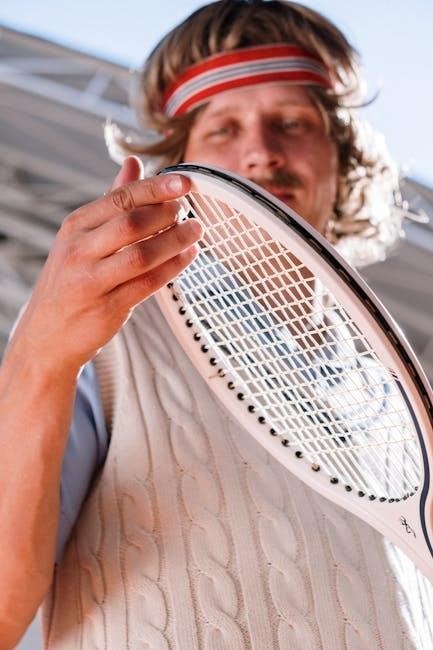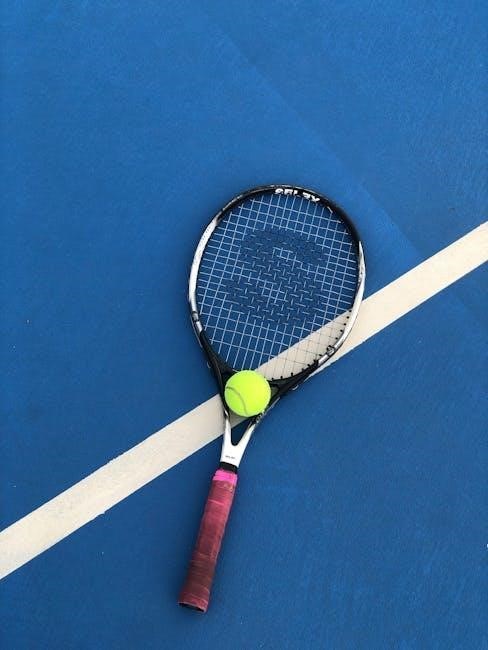Importance of Choosing the Correct Tennis Racquet Grip Size
Choosing the correct tennis racquet grip size is crucial for optimal control, comfort, and performance. A proper fit ensures better accuracy and reduces the risk of discomfort or injury.
1.1. How Grip Size Affects Performance and Comfort
A proper grip size significantly impacts both performance and comfort. A grip that is too small can lead to excessive hand movement, affecting accuracy and control. Conversely, a grip that is too large can restrict wrist motion, limiting power and precision. The right grip size allows for a firm yet comfortable hold, enabling better racquet control and reducing fatigue during long matches. It also minimizes the risk of discomfort or injury, such as tennis elbow, which can arise from improper grip fit. Thus, ensuring the correct grip size is essential for optimizing both performance and long-term playing comfort.

How to Measure Hand Size for Tennis Racquet Grip
Measure hand size by aligning a ruler with the bottom lateral crease of the palm and extending it to the tip of the ring finger for accuracy.
2.1. The Golden Rule for Determining Grip Size
The golden rule for determining grip size involves measuring the distance between the tip of the ring finger and the middle of the palm. This method ensures a proper fit, as it directly correlates to how the hand naturally grips the racquet. By aligning a ruler with the bottom lateral crease of the palm and extending it to the tip of the ring finger, players can accurately assess their ideal grip size. This technique is widely regarded as the most reliable way to determine comfort and control. The measurement typically falls between 4 inches and 4-5/8 inches, corresponding to standard grip sizes. This rule helps prevent issues like discomfort or injury by ensuring the grip fits naturally.
2.2. Measuring the Distance Between the Tip of the Ring Finger and the Middle of the Palm
To accurately measure grip size, place the ruler at the bottom lateral crease of the palm and align it with the tip of the ring finger. This distance typically ranges from 4 inches to 4-5/8 inches, corresponding to standard grip sizes. The measurement ensures the racquet handle fits comfortably in the hand, allowing for optimal control and reduced risk of injury. Proper alignment and accuracy are crucial, as even a slight discrepancy can affect performance. This method is widely recommended for determining the ideal grip size, ensuring a natural fit and preventing issues like discomfort or restricted movement during play.

Understanding Tennis Racquet Grip Size Options
Tennis racquet grip sizes are typically numbered from 0 to 5, with each size corresponding to specific measurements. These sizes accommodate different hand sizes, ensuring a comfortable fit.
3.1. Standard Grip Sizes (0-5) and Their Corresponding Measurements
Tennis racquet grip sizes are standardized, ranging from 0 to 5, with each size corresponding to specific measurements. Size 0 measures 4 inches, size 1 is 4 1/8 inches, size 2 is 4 1/4 inches, size 3 is 4 3/8 inches, size 4 is 4 1/2 inches, and size 5 is 4 5/8 inches. These measurements ensure a precise fit for players’ hands, promoting comfort and control. The correct grip size is essential for optimal performance, as it directly impacts how securely and effectively a player can hold and maneuver the racquet during gameplay.
The Role of Overgrips in Adjusting Grip Size
Overgrips allow players to customize their racquet’s grip size, offering a thicker handle for better comfort and control without altering the racquet’s original size.
4.1. How Overgrips Can Increase Grip Size by 1/16 Inch
Overgrips are a practical solution for adjusting grip size, typically increasing it by 1/16 of an inch. They are placed over the original grip, providing a thicker handle for improved comfort and control. This is especially useful for players who find their racquet’s grip slightly too small or prefer a larger feel. Overgrips are easy to install and allow customization without permanently altering the racquet. They also offer cushioning and traction, reducing hand fatigue during long matches. For those between standard grip sizes, adding an overgrip can achieve the perfect fit. Regularly replacing overgrips ensures optimal performance and prevents wear from affecting grip size accuracy.

Factors Influencing Grip Size Preferences
Hand size, playing style, handle shape, and personal comfort are key factors influencing grip size preferences. Proper fit ensures optimal performance and reduces injury risks.
5.1. Handle Shape and Its Impact on Grip Size Selection
The shape of the racquet handle significantly influences grip size selection. A rectangular handle may suit players preferring a thinner grip, while an octagonal shape might favor a slightly larger grip. Comfort and control are paramount, as an ill-fitting handle can lead to discomfort or injury. Players should consider their hand size and playing style when selecting a handle shape. For instance, those with larger hands may prefer an octagonal handle for better grip stability. Conversely, smaller hands might find a rectangular handle more comfortable. The golden rule of leaving space between the fingers and palm applies universally. Demoing racquets and using overgrips can help tailor the fit to individual preferences.
How to Choose the Right Grip Size for Your Tennis Racquet
Measure your hand size, apply the golden rule, and consider overgrips to find your ideal fit. Proper sizing ensures comfort, control, and optimal performance on the court.
6.1. Step-by-Step Guide to Selecting the Ideal Grip Size
To select the ideal grip size, start by measuring your hand. Hold a ruler or measuring tape across the palm, aligning it with the bottom lateral crease. Measure to the tip of your ring finger. Use the golden rule: leave a small gap between your fingers and palm for comfort. If your measurement falls between standard sizes (0-5), choose the smaller size and add an overgrip for a custom fit. Demo racquets if possible to ensure the grip feels right. Proper sizing enhances control, reduces fatigue, and minimizes injury risks, ensuring optimal performance and comfort during play.

Common Mistakes to Avoid When Selecting a Grip Size
Common mistakes include ignoring the golden rule, not measuring accurately, and choosing a grip size that’s too large or too small. This can lead to reduced control and discomfort.
7.1. The Risks of Choosing a Grip Size That is Too Large or Too Small
Choosing a grip size that is too large or too small can significantly impact performance and comfort. A grip that is too small may cause the hand to move excessively during swings, leading to poor control and discomfort. Conversely, a grip that is too large can restrict hand movement, making it difficult to generate power and precision. Both scenarios can result in fatigue, blisters, or even long-term injuries such as tennis elbow. Proper fit is essential to maintain consistent performance and prevent discomfort. Always measure accurately and consider using overgrips to fine-tune the size for optimal results.
Tips for Maintaining the Perfect Grip Size
Regularly replace overgrips to ensure a consistent feel and prevent wear. Clean the racquet handle to avoid moisture buildup and maintain grip comfort. Check grip size periodically to accommodate hand changes.
8.1. When and How to Replace Overgrips for Optimal Performance
Overgrips should be replaced when they show signs of wear, such as fraying, thinning, or loss of tackiness. Typically, this occurs after 6-8 matches or heavy use. To replace, start by cleaning the original grip to remove dirt and moisture. Peel off the old overgrip and dispose of it. Take the new overgrip, align it with the butt cap, and wrap it smoothly, avoiding wrinkles. Apply gentle pressure to ensure a snug fit. Finally, dampen your hand slightly and grip the racquet to mold the overgrip to your hand shape; Regular replacement ensures consistent grip size, comfort, and performance.
